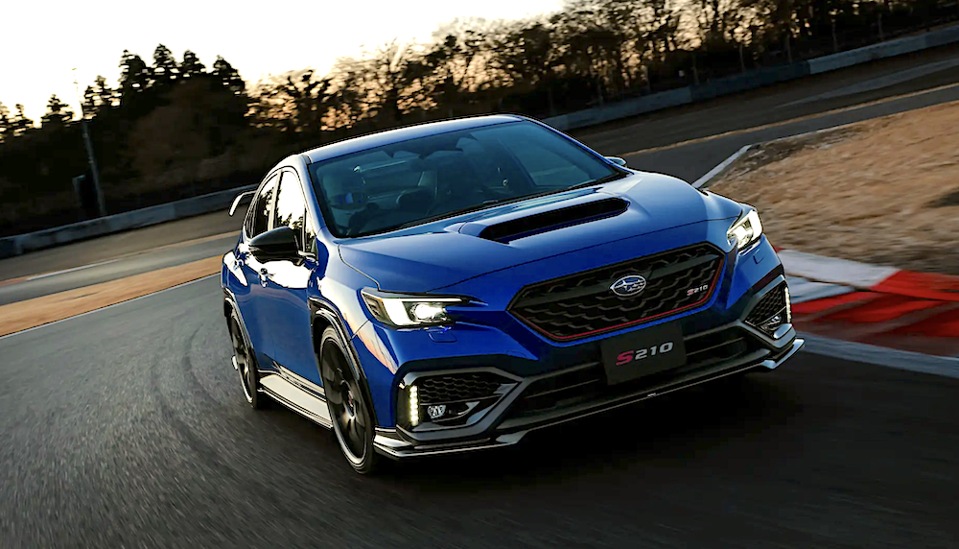The STI S210 could well be the last pure turbocharged, boxer-engined, gasoline powered sports sedan made by Subaru before the model is hybridized. The S210 is based on the WRX S4 sedan but employs upgrades and bespoke parts that elevate this car from ballsy to ballistic.
But like all super high achievers, there are conditions—it will be limited to just 500 units, it has no 6-speed manual option, and all are destined for Japanese buyers only. For the present at least. Subaru may consider a US-spec model in the future.
And it also just happens to be one of the most expensive Subarus ever, setting buyers back some ¥8.6 million or around US$60,000. The most expensive was the WRX STI S209 launched in 2019, of which 209 units were sold in the US for $63,995 when new. One sold in October 2023 for $68,500.
The S210 styling is more subtle than you’d expect with accentuated front bumper brake ducts, blacked out wheel arches, BBS wheels, red STI accents and a massive rear wing which generates downforce above 100 mph.
No 6-speed manual gearbox is offered!
The STI is powered by a 2.4-litre turbocharged boxer engine pumping out 296 hp and 277 lb-ft of torque. This time however, the high priced STI comes with a twist—no 6-speed manual option. Yee gads! That’s a brave move from STI. This time the car is only offered with a continuously variable transmission which is a gearbox not that popular outside of Japan, especially on high performance models. According to Subaru, the reasoning for going all in for the CVT is to make the S210 a more refined, more mature, more track capable machine.
And speaking of track compatibility, this car takes the base S4 sedan and throws the entire STI parts bin at the S210, a bin filled with race-tuned parts from the company’s long competition and storied multiple category victories in Germany’s famed Nurburgring 24-hour race. For greater cornering rigidity the S210 gets an STI front flexible draw tower bar and stiffeners, rear stabilizer bushes, bespoke ECU and transmission control unit, 6-piston Brembo brakes with drilled rotors and bespoke pads, an STI performance muffler and exhaust pipe, 19-inch Michelin Pilot Sport 4S tyres, ZF electronically-controlled dampers and coil springs, and bespoke drive mode select.
The S210 gets Recaro seats and 6-piston Brembo brakes
Inside it gets leather 8-way Recaro bucket seats that provide great leg and back support in corners, a bespoke S210 designed dash with red accents, seatbelts and STI badging and stitching, aluminum pedals and a red start/stop switch. It’s not as luxurious as say an M3, but the materials used and the styling certainly elevates the cockpit to something approaching the BMW.
As we mentioned above the S210 is based on the the STI S4 sedan. So you’d expect the new STI model to feel like a tweaked S4. Not so. At a brief S210 prototype test drive at Izu’s Cycle Sport Center south of Tokyo recently, it became blatantly obvious that the new model is totally different. In fact it feels borderless now—it does not feel like a Japanese car. It feels a lot closer to a BMW M3 or an AMG C43 in terms of ride quality and cornering ability. But the S210’s equivalent $60,000 is a lot cheaper than the M3’s $77,000 or the C43’s $67,000.
Even though the test drive was held in semi-wet conditions, the S210 launched into corners and negotiated them better and with far greater stability than an M3 or C43 could. Indeed, STI claims the car has 296 hp, but when floored, the S210 feels like it has at least 320 hp or more as acceleration is impressive.
The car’s combination of superior 4-wheel traction thanks to its rally and race-proven AWD system and Michelin grip, improved twist and bend rigidity and massive Brembo brakes that wipe off speed instantly, the S210 tempts you to push harder in each corner.
Critics may question the car’s throttle response given its CVT-only offering. But thanks to a tuned ECU, tweaked transmission control unit and new sports exhaust system, turbo lag is basically non-existent, and throttle response is quick as the turbo spools up briskly. And the normally sluggish CVT has been tuned to deliver quicker changes that don’t leave the driver wanting for more.
The only question is how many hardcore Subaru fans are willing to fork over ¥8.6 million or around $60,000. With the current dollar-yen exchange rate that amount may not sound that much, but in real terms, an ¥8.6 million car feels more like an $80,000 to American buyers in terms of value. Who knows if they aren’t able to sell them quickly in Japan, then they might offer the remaining stock to right-hard-drive countries like the UK or Australia.

